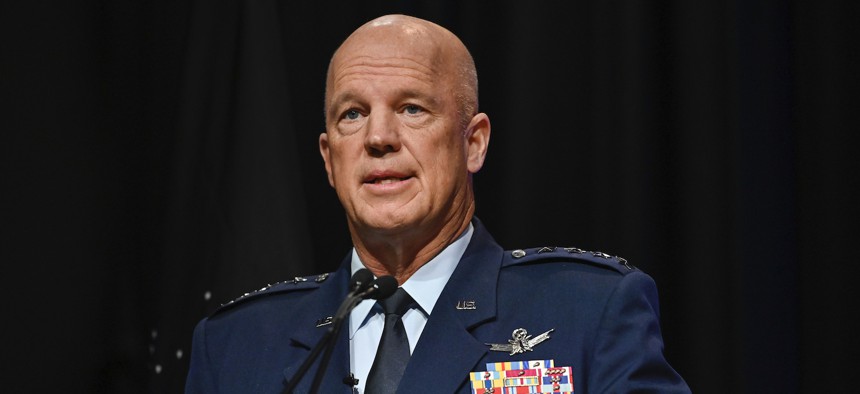
Chief of Space Operations Gen. John W. Raymond delivers remarks during a ceremony at the Pentagon transferring airmen into the U.S. Space Force, Arlington, Va., Sept. 15, 2020. U.S. Air Force photo by Eric Dietrich
US Space Force Becomes 18th Member of US Intelligence Community
Growing threats to U.S. space assets require more intelligence collaboration, senior official says.
Today, the U.S. Space Force, the newest branch of the military, joins the IC. Its mission: monitor threats to U.S. satellites and other space-based assets.
For decades, the United States Intelligence Community has used satellites to collect intelligence on its enemies’ activities on the ground. The Space Force intelligence division function will monitor threats to these satellites and will start off “trying to look at what are the characterizations of things in space that might be hostile,” one senior intelligence official said. “… It all blends together very seamlessly and bringing them into the intelligence community ensures that.”
Gen. John Gen. Raymond, chief of U.S. Space Operations, said in a statement: “This is a significant milestone, a clear statement that America is committed to a secure and accessible space domain. Our partnership will ensure the Space Force and the Nation remain always above any threat.”
On Friday, the Space Force became the 18th member of the IC; it’s the first time since 2006 that a new organization has been admitted to a group that includes the Office of the Director of National Intelligence, CIA, Defense Intelligence Agency, National Security Agency, National Geospatial-Intelligence Agency, National Reconnaissance Office, Army, Navy, Marine Corps, and Air Force.
The move is more than symbolic, the official told Defense One. Russian, Chinese, and other nations’ space capabilities are growing as quickly as U.S. reliance on space.
Military leaders and other officials have become increasingly public about those threats. In June 2018, Defense Intelligence Agency head Gen. Robert Ashley, speaking at the Defense One Tech Summit, said that Russia and China were developing “the ability to interdict satellites both from a ground standpoint and from a space standpoint … The technology is being developed right now. It is coming in the near future.”
A January 2019 Competing in Space Assessment from the Air Force and The National Air and Space Intelligence Center states “A number of foreign countries are believed to be testing on-orbit, space-based anti-satellite technologies and concepts. China and Russia continue to conduct sophisticated on-orbit activities that may advance counter-space capabilities.”
Skip ahead to July 2020 and the dramatic U.S. Space Command announcement that Russia had tested a satellite that could ram other satellites, a direct threat to U.S. satellites including— potentially — those that provide early warning of nuclear missile launches.
“The sophistication and the breadth of capabilities that we are seeing our adversaries develop is dramatic in its increase over the last few years,” the senior defense official said. “The provocative behavior of the Russians and the wholesale development of new capabilities that the Chinese are pursuing are what we have documented in the public record. The ability also to discriminate between all the new commercial capabilities and civilian capabilities that are flooding into space” is also a priority.
”What they’re doing is focusing on characterizing through space domain awareness everything that’s up there that might become an immediate threat,” the official added. “It couldn’t be more important given the dependence of American way of life on our space-based capabilities--not just military but all our civilian and new emerging commercial marketplace that’s up in place.”





